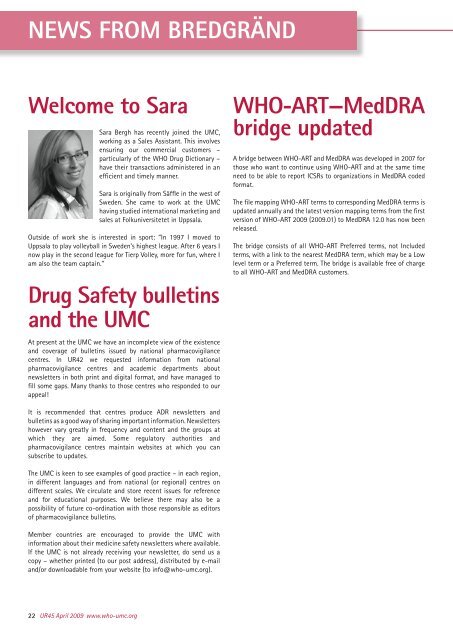April 2009 - Uppsala Monitoring Centre
April 2009 - Uppsala Monitoring Centre
April 2009 - Uppsala Monitoring Centre
You also want an ePaper? Increase the reach of your titles
YUMPU automatically turns print PDFs into web optimized ePapers that Google loves.
NEWS FROM BREDGRäNDWelcome to SaraSara Bergh has recently joined the UMC,working as a Sales Assistant. This involvesensuring our commercial customers –particularly of the WHO Drug Dictionary –have their transactions administered in anefficient and timely manner.Sara is originally from Säffle in the west ofSweden. She came to work at the UMChaving studied international marketing andsales at Folkuniversitetet in <strong>Uppsala</strong>.Outside of work she is interested in sport: “In 1997 I moved to<strong>Uppsala</strong> to play volleyball in Sweden’s highest league. After 6 years Inow play in the second league for Tierp Volley, more for fun, where Iam also the team captain.”Drug Safety bulletinsand the UMCAt present at the UMC we have an incomplete view of the existenceand coverage of bulletins issued by national pharmacovigilancecentres. In UR42 we requested information from nationalpharmacovigilance centres and academic departments aboutnewsletters in both print and digital format, and have managed tofill some gaps. Many thanks to those centres who responded to ourappeal!WHO-ART–MedDRAbridge updatedA bridge between WHO-ART and MedDRA was developed in 2007 forthose who want to continue using WHO-ART and at the same timeneed to be able to report ICSRs to organizations in MedDRA codedformat.The file mapping WHO-ART terms to corresponding MedDRA terms isupdated annually and the latest version mapping terms from the firstversion of WHO-ART <strong>2009</strong> (<strong>2009</strong>.01) to MedDRA 12.0 has now beenreleased.The bridge consists of all WHO-ART Preferred terms, not Includedterms, with a link to the nearest MedDRA term, which may be a Lowlevel term or a Preferred term. The bridge is available free of chargeto all WHO-ART and MedDRA customers.It is recommended that centres produce ADR newsletters andbulletins as a good way of sharing important information. Newslettershowever vary greatly in frequency and content and the groups atwhich they are aimed. Some regulatory authorities andpharmacovigilance centres maintain websites at which you cansubscribe to updates.The UMC is keen to see examples of good practice – in each region,in different languages and from national (or regional) centres ondifferent scales. We circulate and store recent issues for referenceand for educational purposes. We believe there may also be apossibility of future co-ordination with those responsible as editorsof pharmacovigilance bulletins.Member countries are encouraged to provide the UMC withinformation about their medicine safety newsletters where available.If the UMC is not already receiving your newsletter, do send us acopy – whether printed (to our post address), distributed by e-mailand/or downloadable from your website (to info@who-umc.org).22 UR45 <strong>April</strong> <strong>2009</strong> www.who-umc.org
















